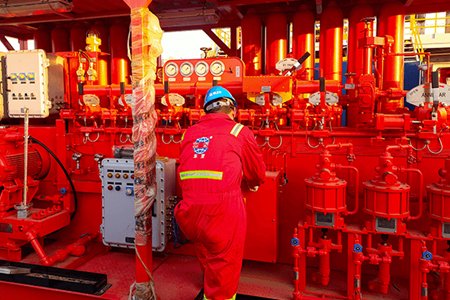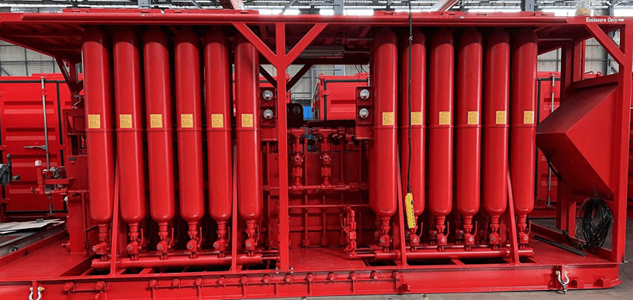In the oil and gas industry, ensuring the integrity and functionality of equipment is paramount to maintaining safety and operational efficiency. One critical component that demands rigorous testing is the Blowout Preventer (BOP). The low pressure test for a BOP is a crucial procedure that ensures the device’s reliability under operational conditions. This article delves into the specifics of what a low pressure test for a BOP entails, its importance, the procedures involved, and the standards governing these tests.
A Blowout Preventer (BOP) is a specialized valve or mechanical device used to seal, control, and monitor oil and gas wells. Its primary function is to prevent blowouts, which are uncontrolled releases of crude oil or natural gas from wellbore formations. BOPs are essential for ensuring safety and preventing environmental disasters during drilling operations.

BOPs come in various types, including:
Annular BOP: Uses a rubber sealing element that can close around any object in the wellbore or seal the wellbore entirely.
Ram BOP: Uses steel rams to seal the wellbore. There are different types of ram BOPs, including pipe rams, blind rams, and shear rams.
Importance of BOP Testing
Testing BOPs is crucial to ensure they function correctly during an emergency. Regular testing helps identify potential issues before they escalate, ensuring the safety of personnel, equipment, and the environment.
Definition and Purpose
The low pressure test for a BOP is a procedure that involves applying a specified low pressure to the BOP system to verify its ability to hold and seal against the applied pressure without leaking. This test is conducted to ensure that the BOP can maintain its integrity under low pressure conditions, which is essential for detecting any weaknesses or potential failure points.
Low pressure tests are typically conducted during:
Initial Installation: To verify the integrity of the BOP system before commencing drilling operations.
Routine Maintenance: Regular intervals as part of ongoing maintenance to ensure continued reliability.
After Repairs or Modifications: To confirm that repairs or modifications have not compromised the BOP’s integrity.
Preparation
Before conducting a low pressure test, several preparatory steps are essential:
Inspection: Visual inspection of the BOP and associated equipment to identify any visible issues.
Calibration: Ensuring that all pressure gauges and testing equipment are calibrated and functioning correctly.
Documentation: Reviewing the testing procedures and ensuring all necessary documentation and permits are in place.
Testing Steps
The low pressure test for a BOP generally involves the following steps:
Isolation of the BOP: Isolate the BOP from the rest of the wellbore to ensure accurate testing conditions.
Pressure Application: Apply a specified low pressure, typically around 200 to 300 psi, to the BOP system using a dedicated pressure source.
Monitoring: Monitor the pressure gauges and the BOP for a specified duration, usually 10 to 15 minutes, to check for any pressure drops or leaks.
Inspection: Conduct a thorough inspection of the BOP and associated components to identify any signs of leaks or weaknesses.
Recording Results: Document the test results, including the applied pressure, duration, and any observed anomalies.
Interpreting Results
Successful completion of the low pressure test is indicated by the BOP holding the applied pressure without any significant drops or leaks. Any failure to maintain pressure indicates potential issues that must be addressed before the BOP can be deemed operationally safe.
Industry Standards
Several industry standards govern the testing of BOPs, ensuring consistency and reliability across the industry. Key standards include:
API Standard 53: Developed by the American Petroleum Institute (API), this standard outlines the requirements for BOP systems and equipment, including testing procedures.
ISO 13533: The International Organization for Standardization (ISO) provides guidelines for BOP equipment and testing.
Regulatory Requirements
Regulatory bodies impose strict requirements for BOP testing to ensure safety and environmental protection. Key regulatory agencies include:
Bureau of Safety and Environmental Enforcement (BSEE): In the United States, BSEE oversees offshore oil and gas operations, including BOP testing requirements.
Occupational Safety and Health Administration (OSHA): OSHA sets standards for workplace safety, including the testing and maintenance of BOP systems.
Documentation and Compliance
Operators must maintain comprehensive records of all BOP tests, including low pressure tests. These records are essential for demonstrating compliance with industry standards and regulatory requirements. Regular audits and inspections ensure adherence to these standards.

Common Challenges
Conducting low pressure tests for BOPs can present several challenges, including:
Harsh Operating Environments: Offshore and remote locations can pose logistical challenges and impact testing accuracy.
Equipment Reliability: Ensuring the reliability and calibration of testing equipment is crucial for accurate results.
Regulatory Compliance: Navigating complex regulatory requirements can be challenging, requiring meticulous documentation and adherence to standards.
Best Practices
To overcome these challenges and ensure effective low pressure testing, operators should adopt the following best practices:
Regular Training: Provide ongoing training for personnel involved in BOP testing to ensure they are familiar with the latest procedures and standards.
Comprehensive Documentation: Maintain detailed records of all tests, including calibration certificates for testing equipment.
Proactive Maintenance: Implement a proactive maintenance program to identify and address potential issues before they impact testing.
Collaboration with Experts: Work with industry experts and third-party inspectors to ensure testing procedures align with best practices and regulatory requirements.
The low pressure test for a BOP is a fundamental procedure that plays a critical role in ensuring the safety and reliability of oil and gas operations. By verifying the integrity of the BOP system under low pressure conditions, operators can identify potential weaknesses and address them proactively. Adherence to industry standards and regulatory requirements, coupled with best practices in testing and maintenance, is essential for maintaining the highest levels of safety and operational efficiency. In an industry where the stakes are high, rigorous testing of BOPs, including low pressure tests, is indispensable for safeguarding personnel, equipment, and the environment.
By continuing to use the site you agree to our privacy policy Terms and Conditions.